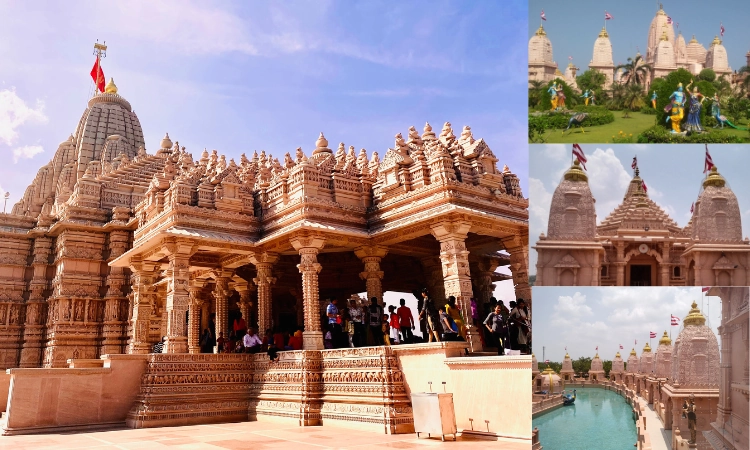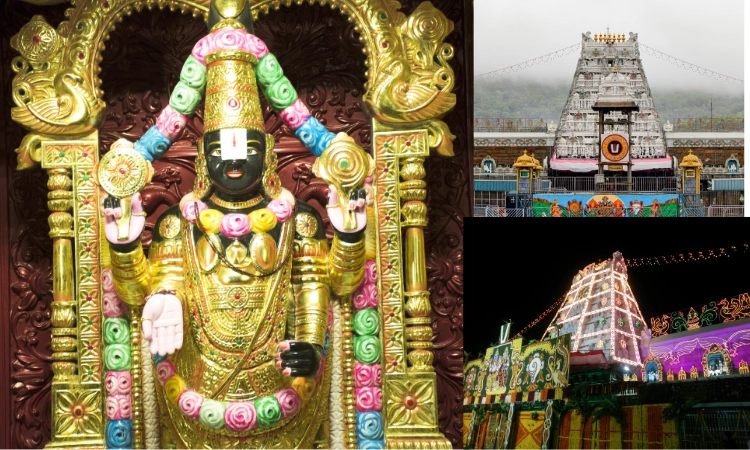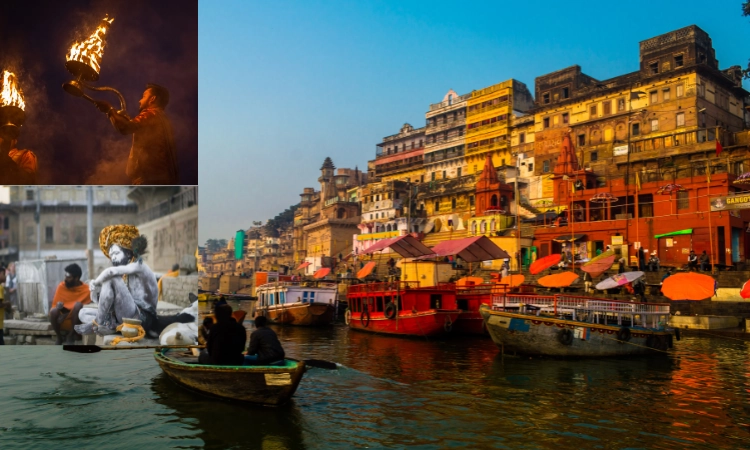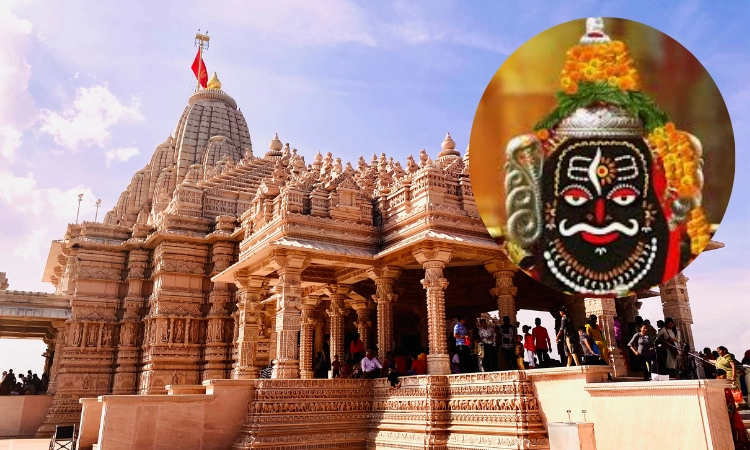India’s temple towns are no longer just spiritual destinations; they’re becoming real estate goldmines. With increasing footfall from domestic and international pilgrims, these towns are now prime hotspots for faith-based real estate investment. Smart investors are eyeing plots near temples, budget hotels, and rental homes for long-term gains.

Table of Contents
Rise of Faith-Based Tourism in India
Faith-based tourism is booming across India. Millions of devotees travel every year to sacred places like Tirupati, Varanasi, Puri, and Ayodhya. The numbers are growing fast due to improved connectivity, rising incomes, and stronger emotional ties to cultural roots.
The PRASHAD (Pilgrimage Rejuvenation and Spiritual Augmentation Drive) scheme and Swadesh Darshan scheme have played a big role in boosting this trend. These government initiatives improve amenities, attract private investments, and enhance the spiritual experience.
Religious festivals like Kumbh Mela, Rath Yatra, and Ram Navami now draw global attention. For real estate investors, this means a steady stream of footfall, higher rental demand, and long-term potential in faith-based real estate.
Why Temple Towns Are Emerging Real Estate Hotspots?
Temple towns are transforming into dynamic real estate markets. These spiritual centers now offer more than just religious experiences, they offer investment-worthy infrastructure.
Here’s why:
- Consistent Demand: Devotees visit year-round. This creates ongoing demand for rentals, guesthouses, and commercial spaces.
- Low Entry Barrier: Temple town plots are more affordable than metro cities.
- High Returns: Land prices in cities like Ayodhya and Tirupati have seen 3–5X growth in a few years.
- Emotional Investment: Many buyers seek spiritual peace, not just profit.
Religious real estate is no longer just traditional. It’s becoming strategic. Cities backed by infrastructure upgrades and emotional value are now prime targets for spiritual city investment.
Historical Value and Cultural Significance of Temple Towns
Temple towns are more than just tourist spots, they are living heritage sites. Cities like Varanasi, Ujjain, Tirupati, and Puri have been sacred for centuries. These places carry deep spiritual meaning and historical continuity. Investing in such locations taps into India’s cultural heartbeat. The architecture, rituals, festivals, and daily spiritual practices create an aura that no modern city can replicate.
This emotional and historical depth adds a timeless value to pilgrimage property. Buyers feel connected not only to the land but to a spiritual legacy. This sense of belonging strengthens demand and gives religious real estate long-term stability. Heritage cities also attract NRIs, spiritual seekers, and culture-focused travelers, making them ideal for guesthouses, rentals, and temple town plots.
Government-Backed Development in Pilgrimage Corridors
The government is investing heavily in temple towns. These areas are being developed with better roads, clean facilities, and smart city features. Major projects like the Kashi Vishwanath Corridor and Ram Mandir complex in Ayodhya are transforming these towns.
Under the PRASHAD scheme, cities like Varanasi, Tirupati, and Puri are getting new look. This includes wide roads, parking areas, sanitation, and tourist help centers. The government is also improving train stations and airport access in these towns.
Impact of the PRASHAD and Swadesh Darshan Schemes
The PRASHAD (Pilgrimage Rejuvenation and Spiritual Augmentation Drive) scheme upgrades religious cities by funding modern facilities. The Swadesh Darshan scheme helps improve travel circuits across spiritual zones. Both projects are turning temple towns into better places to live, visit, and invest.
These schemes:
- Boost real estate demand
- Raise land prices
- Bring in hotel chains and retail brands
- Help cities grow in a planned way
Many temple towns now offer solid returns on faith-based real estate.
Key States Actively Promoting Religious Tourism
Several Indian states are building strong religious tourism hubs:
- Uttar Pradesh – invest in Ayodhya, Kashi, Mathura
- Andhra Pradesh – real estate Tirupati, Srisailam
- Madhya Pradesh – Ujjain, Omkareshwar
- Odisha – Puri, Konark
- Tamil Nadu – Rameswaram, Kanchipuram
- Uttarakhand – Haridwar, Kedarnath, Badrinath
These states offer policy support, faster clearances, and tax benefits to real estate developers. This means more investment opportunities for you.
Types of Investment Opportunities in Temple Towns
Temple towns offer many ways to invest. You can pick what suits your budget and goal.
- Residential Plots and Rental Homes for Devotees: Buy temple town plots and build small homes. Rent them to visiting families or elderly pilgrims. Many prefer to stay near temples during festivals.
- Budget Hotels and Guesthouses Near Shrines: Low-cost guesthouses are always in demand. You can earn well, especially during peak seasons like Navratri, Ram Navami, or Rath Yatra.
- Commercial Spaces and Shops Around Temple Premises: Shops selling flowers, food, puja items, and clothes do great business near temples. Renting out small shops can give stable income.
- Weekend and Holiday Home Potential: Some buyers prefer owning a quiet holiday home near spiritual places. These can double up as homestays or retreat spots for guests.
Residential Plots and Rental Homes for Devotees
Many families visit temples during festivals or special days. They prefer staying in peaceful, clean homes near the temple. This creates demand for rental homes.
You can buy plots near temples, build small homes, and rent them out. These homes are usually full during festival months. Some people even book them for a full week or month.
If you don’t want to build now, just buy a residential plot and hold it. As the town grows, the value will go up.
Budget Hotels and Guesthouses Near Shrines
Every temple town needs places to stay. Not everyone can afford luxury hotels. This is where budget guesthouses and low-cost hotels come in.
Devotees usually stay for 1–3 days. If your property is near the temple, railway station, or main road, it will be in high demand.
You can earn regular income during festivals and weekends. Many investors start small, just 5–10 rooms. Over time, they grow their property.
Commercial Spaces and Shops Around Temple Premises
Shops near temples never go out of business. Pilgrims always need items like:
- Flowers and coconuts
- Puja samagri (worship items)
- Snacks, water, and sweets
- Souvenirs and religious books
If you own a small commercial space, you can rent it to shopkeepers. Some people also open their own stores or set up vending stalls.
Weekend and Holiday Home Potential
Temple towns are peaceful and spiritual. Many people now want a second home in such places. These homes are used for:
- Quiet weekends
- Spiritual retreats
- Family visits during festivals
This is popular with NRIs and older couples. They enjoy coming to a calm, holy place for rest. Weekend homes can also be rented when not in use. This way, you earn money and have a place to relax when you visit.
Infrastructure Improvements Around Religious Zones
Temple towns are getting modern upgrades:
- Smooth roads
- Better lighting
- Clean water and sanitation
- Electric buses and parking zones
- Signboards and maps for tourists
These changes make travel easy for devotees. The PRASHAD scheme to many towns looks cleaner and feel safer. This makes them attractive for real estate investors.
Demand from NRIs and Devotees Across India
Many NRIs and people from big cities want to stay connected to their culture. They buy land or homes in temple towns to:
- Visit once or twice a year
- Host parents and relatives
- Retire in a spiritual place
This creates strong demand. In cities like Tirupati, Ayodhya, and Puri, NRIs are buying pilgrimage property for both emotion and profit.
Vastu Compliance and Spiritual Factors in Buying
In religious places, people care about more than just price. They look for:
- East or North-facing plots (believed to bring peace)
- Homes close to temples, but not in noisy areas
- Places near rivers, ponds, or sacred trees
- Vastu-friendly layouts (for health, harmony, and luck)
These features are very important in spiritual city investment. Buyers are ready to pay extra for the right energy and blessings.
Risks of Seasonal Footfall and Off-Season Vacancies
Temple towns get very busy during festivals. But during other months, the number of visitors can drop.
This means:
- Hotels may stay empty
- Shops may earn less
- Homes may not get rented
This is called seasonal footfall. It affects income for a few months each year. Also, some areas are very crowded or hard to reach. That can make it hard to sell or rent property later.
Smart tip: Choose locations with steady visitor’s year-round—like Tirupati or Varanasi.
Legal and Zoning Considerations for Pilgrimage Areas
Before buying any land or home near a temple, check the rules. Important things to check:
- Is the land zoned for residential, commercial, or religious use?
- Is the ownership clear? Any legal issues or old claims?
- Does the area have building rules or height limits near temples?
- Is the builder RERA-registered?
Ask a local lawyer or agent to help. This will save you from future problems.
Top Temple Towns to Watch
1. Ayodhya (Uttar Pradesh)
Land prices have gone up fast after the Ram Mandir project. Good for buying plots, flats, or opening shops.

2. Tirupati (Andhra Pradesh)
One of the most visited temples in India. Real estate Tirupati is growing with strong rental and hotel demand.

3. Varanasi (Uttar Pradesh)
Kashi Vishwanath Corridor is a big success. Good for guesthouses and homes near the ghats.

4. Ujjain (Madhya Pradesh)
New Mahakal Lok has increased pilgrim numbers. Shops and homestays are doing well.

5. Puri (Odisha)
Famous for Jagannath Temple and sea tourism. Popular for weekend homes and budget hotels.
The Role of Public Sentiment and Emotional Value
Many people invest in temple towns not just for profit, but for peace and blessings. They feel connected to the place. Some want to:
- Build a home for their parents
- Spend festivals near a holy place
- Give back to the temple town they love
This emotional reason is strong. It keeps real estate demand high, even when prices rise.
Case Studies of Successful Pilgrimage Town Investments
- Tirupati: A man bought land in 2017 for ₹7 lakh. He built a 6-room guesthouse. Today, he earns ₹45,000/month in peak season.
- Ayodhya: A family bought a plot in 2020 for ₹1,200/sq.ft. Now, it’s worth ₹4,800/sq.ft. after the Ram Temple opening.
- Ujjain: A woman rented a small shop near the temple. She sells puja items and earns ₹2,000/day during festivals.
Future Trends in Faith-Based Real Estate Investment
Temple towns will grow in new ways:
- Homes for senior citizens near temples
- Spiritual wellness centers with yoga and meditation
- Branded hotels and guesthouses near shrines
- Group investment through Devotional REITs
- More temple town plots sold through government auctions
These trends will create fresh chances to invest with both purpose and profit.
Conclusion
Temple towns are not just for prayers anymore. They are full of real estate opportunities. From plots near temples to guesthouses and shops, you can invest in ways that are both meaningful and smart. With help from the PRASHAD scheme, better roads, and rising devotional tourism, now is a great time to invest in Ayodhya, Tirupati, Ujjain, and more.
More information
Stay updated on the latest developments in the real estate industry by following the openplot information.
Our platform offers valuable insights and updates, along with informative articles and market reports. Openplot.com helps find or sell a home, which is a significant milestone.
Frequently Asked Questions
Q. Is it a good idea to invest in plots near temples?
Yes. Temple town plots are in demand due to religious tourism, government development, and emotional value. Many investors have seen strong returns in places like Ayodhya, Tirupati, and Ujjain.
Q. What is the PRASHAD scheme, and how does it help investors?
The PRASHAD scheme improves roads, sanitation, and public facilities in pilgrimage towns. Better infrastructure leads to higher property value and more rental income.
Q. Can NRIs invest in pilgrimage property in India?
Yes. NRIs can buy residential or commercial property in temple towns. Many do it for spiritual connection or to build a family home for visits.
Q. What are the risks of investing in temple towns?
Some risks include seasonal footfall, zoning restrictions near temples, and fewer buyers in off-season. But choosing the right location and property type can reduce these risks.
Q. What kind of property gives good returns in spiritual cities?
- Guesthouses and homestays do well during festivals
- Shops near temples earn daily income
- Plots near future projects like temple corridors appreciate fast